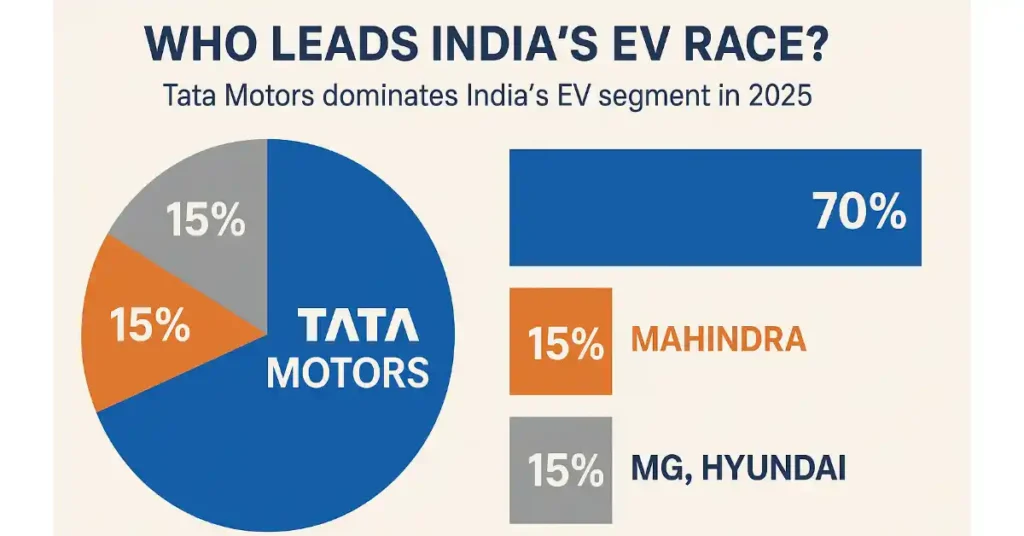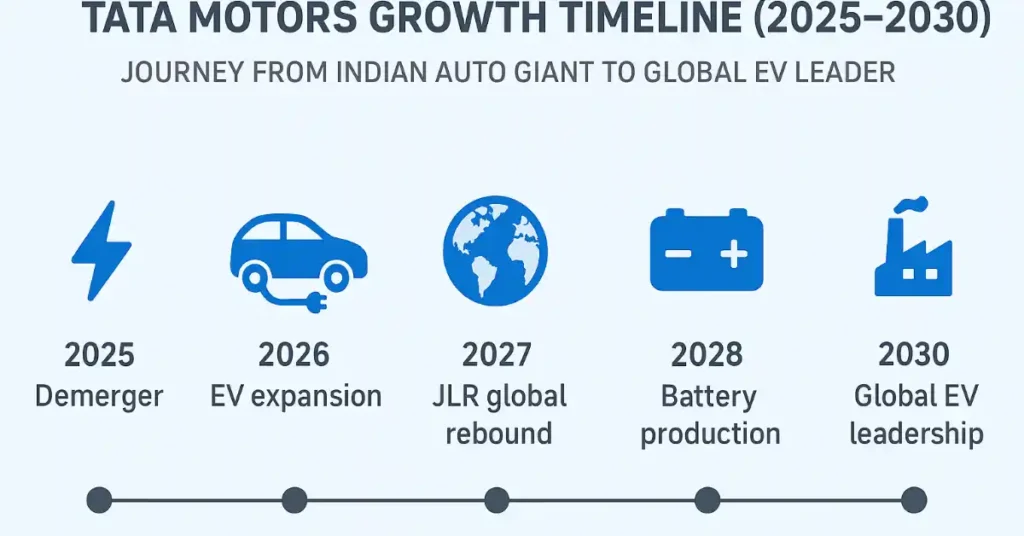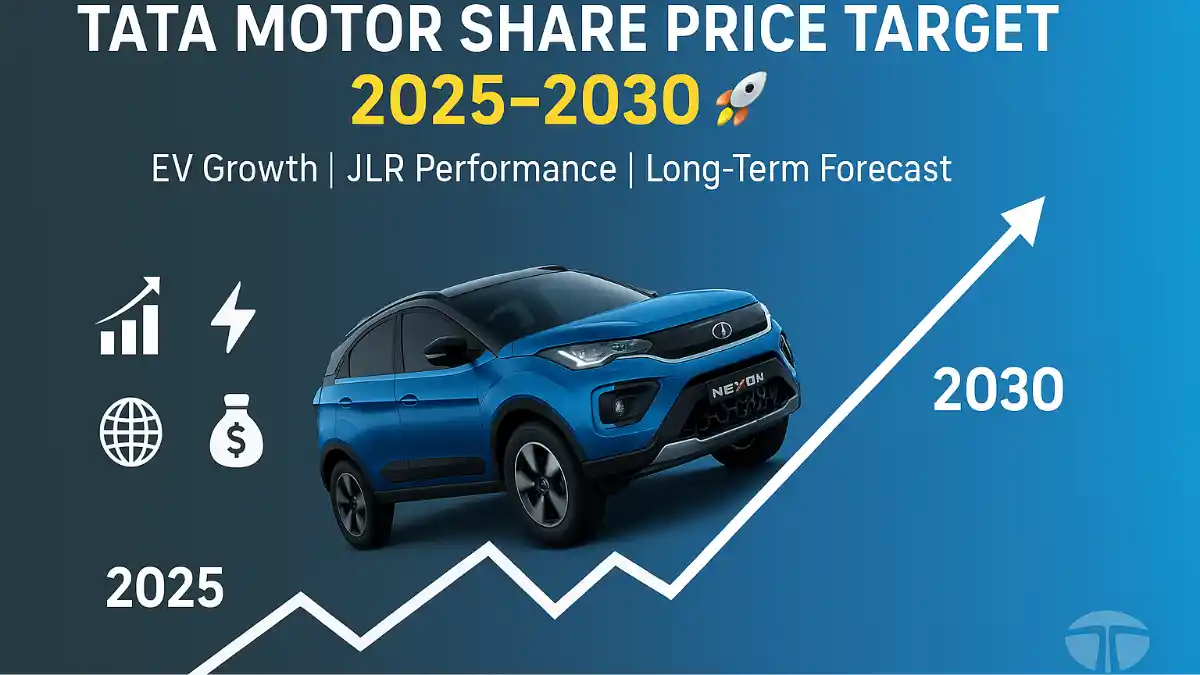Explore Tata Motor share price target 2025 – 2030 , stock forecast, EV growth, demerger impact, valuation, and expert predictions.
Introduction: The Rise of Tata Motor and Its Future Potential
Tata Motor Limited (NSE: TATAMOTOR) is one of India’s most trusted automobile brands. Over the past few years, the company has evolved from a traditional automaker into a future-ready mobility player with a strong focus on electric vehicles (EVs), sustainability, and global expansion through Jaguar Land Rover (JLR).
In this article, we’ll cover an in-depth Tata Motor share price target, its future forecast till 2030, and what makes it a promising candidate for long-term investment.
We’ll also break down its EV business, demerger impact, and expert price predictions — all backed by the latest data and analysis.
Current Overview: Tata Motor Share Price Today
As of October 2025, Tata Motor share price today hovers around ₹397.00 on NSE.
| Metric | Value (Approx.) |
|---|---|
| Current Price | ₹397.00 |
| 52-Week High / Low | ₹935.35 / ₹376.30 |
| Market Cap | ₹2.4 Lakh Crore |
| P/E Ratio | 6.7 |
| ROE | ~28% |
| Debt Level | Moderate |
| Book Value | ₹300+ per share |
Tata Motor stock price history shows steady growth since 2020, reflecting investor confidence in the company’s future growth and EV business strategy.
Tata Motor Company Overview
Tata Motor part of the Tata Group, manufactures passenger vehicles, commercial vehicles, SUVs, trucks, and electric vehicles.
Its key business divisions include:
- Passenger Vehicle (PV) segment
- Commercial Vehicle (CV) segment
- Jaguar Land Rover (JLR) luxury brand
- Tata Motor EV Business (Tata Passenger Electric Mobility)
The company’s goal is clear — to dominate India’s electric vehicle market and expand globally.
Tata Motor EV Business: The Future of Indian Mobility

One of the biggest drivers for Tata Motor share price target 2025 and beyond is its EV business.
Tata Motor currently leads India’s EV market with cars like Nexon EV, Tigor EV, and Tiago EV. With over 70% EV market share in India, Tata Motor aims to sell 1 million electric vehicles by 2030.
Analysts expect the Tata Motor electric vehicle segment to boost revenue and profitability significantly, driving the Tata Motor long-term target price higher.
Government support through EV subsidies, charging infrastructure, and FAME-II policy will further accelerate growth.
Tata Motor Demerger 2025: Unlocking Hidden Value
In 2025, Tata Motor announced a major demerger of its Commercial Vehicle (CV) and Passenger Vehicle (PV + JLR) businesses.
This Tata Motor demerger 2025 aims to:
- Unlock shareholder value
- Allow independent management focus
- Enable sharper capital allocation
- Simplify valuation for investors
Brokerage firm Nomura has set a Tata Motor share price target of ₹365 for the CV entity and ₹367 for the PV/JLR entity post-demerger — giving a combined valuation near ₹730.
Investors believe this move could push Tata Motor share price forecast above ₹900 in the next 1–2 years.
Tata Motor Fundamental Analysis
| Parameter | Observation |
|---|---|
| Profit Margin | Strong improvement since FY23 |
| Revenue Growth | 15–18% CAGR |
| EPS (FY25E) | ₹65+ |
| P/B Ratio | 1.2–1.3 |
| Debt-to-Equity | <1 |
The company’s fundamentals show strong recovery after years of volatility.
The Tata Motor valuation 2025 looks attractive given its improving profit margin, balance sheet, and cash flow generation.
Tata Motor JLR Performance: Global Catalyst
Jaguar Land Rover (JLR), Tata’s UK-based subsidiary, remains a major profit driver.
As global luxury car demand recovers post-2024, JLR’s profitability is expected to rise, contributing to the Tata Motor share price prediction 2025.
The focus on hybrid and electric JLR models (like the electric Range Rover) will position Tata Motor as a global EV competitor.
Tata Motor Stock Analysis: Technical & Trend Outlook
From a technical analysis perspective:
- Support Zone: ₹600–₹620
- Resistance Zone: ₹750–₹800
- Trend: Bullish bias for medium-term
If Tata Motor sustains above ₹700, it could retest its previous highs near ₹900–₹950, aligning with expert Tata Motor share target projections.
Tata Motor Stock Forecast 2025–2030
Let’s analyze short-term and long-term Tata Motor share price prediction based on multiple scenarios:
| Scenario | Year | Share Price Target | Outlook |
|---|---|---|---|
| Bull Case | 2025 | ₹900–₹950 | Strong JLR growth, EV demand surge |
| Base Case | 2025 | ₹720–₹760 | Steady growth, moderate margins |
| Bear Case | 2025 | ₹550–₹600 | Weak demand, global slowdown |
| Long-Term (2030) | 2030 | ₹1,500–₹1,700 | EV dominance, global expansion |
Experts predict Tata Motor share price 2030 could cross ₹1,700, driven by its electric vehicle expansion, debt reduction, and global leadership.
Tata Motor Share Price Target 2025: Expert Predictions
| Brokerage / Platform | Target (₹) | Outlook |
|---|---|---|
| Nomura India | 730 | Bullish |
| ICICI Securities | 750 | Positive |
| Jefferies | 550 | Neutral |
| S&P Global | 763 | Moderate Upside |
| TradingView Analysts | 734–890 | Bullish |
Across sources like Groww, TradingView, and IndMoney, the average Tata Motor share price target 2025 stands near ₹750–₹800 — suggesting moderate upside potential.

Tata Motor Share Price Target 2025
Target Range: ₹750 – ₹900
In 2025, Tata Motor growth will be fueled by its demerger, strong domestic sales, and EV portfolio. Analysts expect steady profit growth as JLR’s performance stabilizes and new electric models drive volume. The company’s focus on cost efficiency and clean mobility will continue to attract long-term investors.
Tata Motor Share Price Target 2026
Target Range: ₹950 – ₹1,050
By 2026, Tata Motor is expected to strengthen its EV ecosystem with new launches in both the passenger and commercial vehicle categories. The demand for Tata Nexon EV, Punch EV, and Tiago EV will push sales higher. Improved export numbers and stronger margins could help the stock sustain above ₹1,000 levels.
Tata Motor Share Price Target 2027
Target Range: ₹1,100 – ₹1,250
Tata Motor international performance through JLR will play a major role in this phase. With new global models and EV technology, JLR’s profitability may expand. A continued bullish sentiment could make Tata Motors a multibagger for investors entering before 2026.
Tata Motor Share Price Target 2028
Target Range: ₹1,250 – ₹1,400
By 2028, Tata Motor will benefit from India’s push toward 100% electric mobility and carbon-neutral goals. The company’s battery plant investments and EV infrastructure will enhance profitability. Strong financial performance and global partnerships may further boost its share price trajectory.
Tata Motor Share Price Target 2029
Target Range: ₹1,350 – ₹1,500
In 2029, Tata Motor is expected to maintain dominance in India’s EV market with over 70% market share. Its strong brand positioning and diversified product range across luxury and commercial vehicles will continue driving valuations. Institutional investors may increase holdings as the company achieves stable global growth.
Tata Motor Share Price Target 2030
Target Range: ₹1,500 – ₹1,700
By 2030, Tata Motor is projected to become one of the top global EV manufacturers from India. Analysts foresee its share price possibly touching ₹1,700, supported by strong fundamentals, global presence, and consistent earnings growth. This makes Tata Motors one of the most promising long-term investment opportunities in the Indian stock market.
Tata Motor Valuation and Methodology
We applied three valuation approaches:
- P/E Multiple Method:
- FY26E EPS: ₹65
- P/E (Base Case): 11x → Target = ₹715
- Sum-of-Parts Valuation (Post Demerger):
- CV Business: ₹365
- PV/JLR Business: ₹367
- Total Target = ₹732
- DCF Method:
- Projected CAGR: 12%
- Target Fair Value ≈ ₹750–₹800
This gives an average fair value of ₹750 per share, supporting our base case forecast.
Risks in Tata Motor Share Price Forecast
- JLR Global Slowdown – UK/Europe demand slump may hurt profits.
- High Raw Material Costs – Inflation could squeeze margins.
- Execution Delays in EV Plans – Slow charging network rollout.
- Currency Fluctuation – Impacts global operations.
- Policy Changes – Reduction in EV subsidies may affect sales.
Investors should monitor these before making long-term investment decisions.
Long-Term Investment Outlook: 2026–2030
For investors wondering “Is Tata Motors a good stock to buy for the long term?” — the answer is Yes, if you believe in India’s EV growth story and Tata’s leadership.
By 2030, the company aims to:
- Achieve 50% of passenger vehicle sales from EVs
- Become debt-free
- Expand global footprint through JLR
- Maintain double-digit profit margins
Thus, the Tata Motor share price prediction for next 5 years remains strongly bullish under a favorable policy and demand environment.
Expert View: Will Tata Motor Share Reach ₹1000 by 2030?
Given the company’s focus on EVs, global expansion, and financial improvement, many analysts believe that Tata Motor share could reach ₹1000–₹1200 by 2028, and possibly ₹1500+ by 2030.
The Tata Motor share price target 2030 will heavily depend on how fast EV adoption scales in India and how JLR performs internationally.
Tata Motor Share Price Forecast After Demerger
After the 2025 demerger, Tata Motor will trade as two independent entities — Tata Motors CV and Tata Motors PV/JLR.
Analysts expect:
- CV Business: ₹365–₹400
- PV/JLR Business: ₹370–₹400
Combined, the post-demerger Tata Motor share price prediction may rise up to ₹900, if both units perform well.
Peer Comparison: Tata Motor vs Mahindra & Others
| Company | P/E | Market Cap | EV Focus | 2030 Outlook |
|---|---|---|---|---|
| Tata Motor | 6.7 | ₹2.5L Cr | Strong | Bullish |
| Mahindra & Mahindra | 14.2 | ₹2.0L Cr | Moderate | Positive |
| Maruti Suzuki | 25+ | ₹3.4L Cr | Low | Neutral |
Tata Motor offers a more value-based entry compared to peers, making it attractive for long-term investors.
FAQs
Q1. What is Tata Motor share price target for 2025?
Around ₹750–₹800 per share based on analyst consensus.
Q2. Is Tata Motor a good stock to buy for long term?
Yes, due to its EV focus, strong fundamentals, and brand trust.
Q3. What is Tata Motor share price prediction for next 5 years?
Targets range from ₹1000 to ₹1300 depending on market conditions.
Q4. How will Tata Motor demerger affect share price?
Likely positive — unlocking separate valuations for CV and PV/JLR.
Q5. Will Tata Motor share reach ₹1500 by 2030?
Possible under a bullish scenario with 15%+ CAGR and EV growth.
Q6. How Tata Motor demerger will impact share price?
The Tata Motor demerger will unlock value, increasing share visibility and potentially boosting valuation post-restructuring.
Q7. Tata Motor share price prediction after EV expansion?
After EV expansion, Tata Motor share may rise toward ₹950–₹1100, backed by dominant EV market share.
Q8. Tata Motor long term investment forecast?
Long-term forecast suggests Tata Motor may reach ₹1500 by 2030 with EV growth and JLR recovery.
Q9. Tata Motor share target as per brokerages?
Brokerages set Tata Motor targets between ₹850–₹900, highlighting EV dominance and improving margins.
Q10. Tata Motor share next target level?
Next Tata Motor share target is ₹800–₹850 short-term, ₹950 medium-term with strong EV momentum.
Conclusion: Tata Motor Future Looks Electrifying
Tata Motor stands at the forefront of India’s automotive revolution. Its EV business, demerger, and JLR recovery position it strongly for sustained growth.
With a base target of ₹750 by 2025 and a long-term projection of ₹1500–₹1700 by 2030, Tata Motor share remains a compelling investment opportunity for those who believe in India’s mobility transformation.
Invest wisely, track quarterly updates, and think long-term.
Disclaimer
This article is for educational purposes only and not financial advice. The Tata Motor share price targets mentioned here are based on public information, analyst reports, and market estimates as of October 2025. Market prices are subject to change due to macroeconomic, geopolitical, and company-specific factors. Investors should conduct their own due diligence or consult a certified financial advisor before making investment decisions. Past performance does not guarantee future results.

